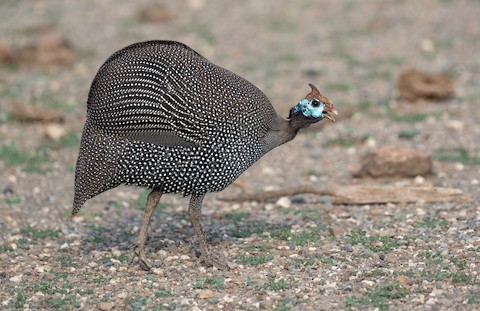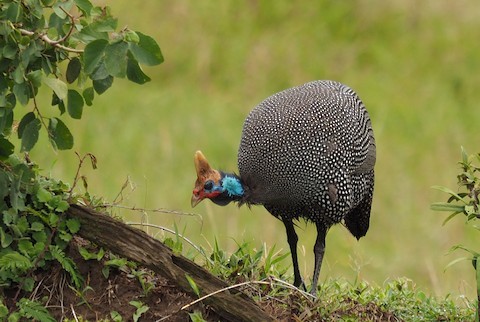Birdfinding.info ⇒ Common and widespread across most of eastern and southern Africa north to Namibia, Zambia, Uganda, and Ethiopia, but uncommon, local, and declining elsewhere. One form, the “Moroccan Guineafowl”, appears to have gone extinct in the 1900s, but may survive ferally or diluted in domestic stock. Another form, the “West African Guineafowl”, has disappeared from most of its natural range, but has been introduced widely both within and outside of Africa. A third form, the “Ethiopian Guineafowl”, is also scarce except locally in protected areas of the northern Rift Valley. The others, “Reichenow’s Guineafowl” and “Tufted Guineafowl”, are generally common and readily observed in protected areas. (For a discussion of the appropriate status of these forms, see Frontiers of Taxonomy: The Many-Helmeted Guineafowl, an Awkward Foursome.)
Helmeted Guineafowl
Numida meleagris
Sub-Saharan Africa, in savannas, brushlands, and various open and semiopen habitats. Consists of five potentially distinct forms—four living and one that may be extinct—which may be best regarded as separate species (see Frontiers of Taxonomy: The Many-Helmeted Guineafowl, an Awkward Foursome):
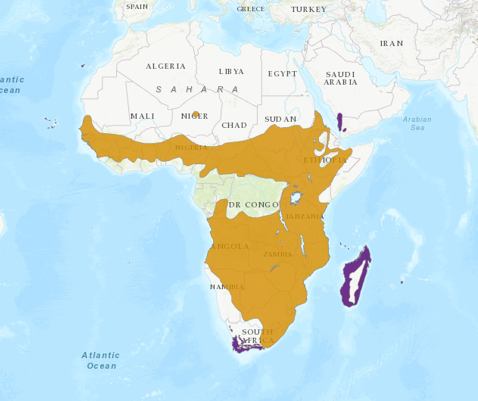
Approximate distribution of the Helmeted Guineafowl (native African range in orange). © BirdLife International 20168
“Moroccan Guineafowl” (N. m. sabyi): Last reported with certainty in the 1950s from northwestern Morocco inland from Rabat—and feral guineafowl that still occur in that area may be primarily descended from this form. Records from the Roman Empire indicate that it historically occurred east to Tunisia.
Reportedly introduced to Barbuda during the colonial period—and may still survive there and perhaps elsewhere in the West Indies—although this remains uncorroborated by contemporary evidence.
“West African Guineafowl” (N. m. galeatus): In the Sahel region from Senegal locally east to southwestern Chad and central Cameroon—but mostly absent from the Guinea highlands, Liberia, and Nigeria. In southwestern Africa from the southern Congo Republic and D.R. Congo south to Namibia (e.g., Caprivi and Hardap). Introduced widely across Africa and beyond (see Introductions below).
“Ethiopian Guineafowl” (N. m. meleagris; including somaliensis): From central Chad and the Central African Republic east across the Sahel to eastern Sudan, Eritrea, and Somaliland, and south to the northern D.R. Congo, Rwanda, and central Kenya.
“Reichenow’s Guineafowl” (N. m. reichenowi): East Africa from southern Kenya to central Tanzania.
“Tufted Guineafowl” (N. m. mitratus; including marungensis, papillosus, and coronatus): Southern Africa from central Angola, eastern D.R. Congo, Rwanda, and eastern Tanzania south to east-central Namibia and northern and eastern South Africa. Introduced across other parts of South Africa south and west to Cape Town, and much of central and southern Madagascar.
Introductions. Centuries of domestication have resulted in feral populations in many parts of the world, although many of these remain semi-domestic, and few have stabilized as fully self-sustaining.
In Africa, each of the extant forms (especially “West African” and “Tufted”) is kept in captivity to some extent, and sometimes occur as releases or escapes outside their natural ranges. “West African” in particular has been introduced locally in southwestern and eastern Africa, with populations in Namibia, Tanzania and adjacent parts of the neighboring countries.
Helmeted Guineafowl that have long been established on the southwestern Arabian Peninsula from the Mecca area to southern Yemen may be either native or introduced, and proximity suggests that these are most likely “Ethiopian.”
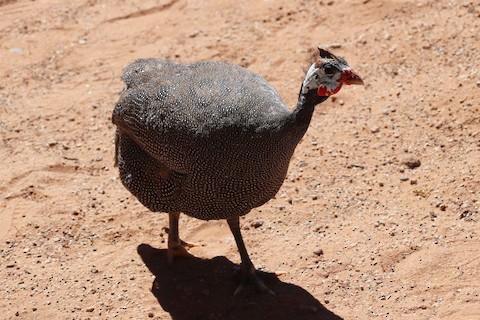
“West African Guineafowl,” N. m. galeatus, a member of one of the feral African populations. (Sossusvley, Hardap, Namibia; April 23, 2018.) © Lorix Bertling
Introduced populations of “West African” are established: on the Cape Verde Islands (Raso, São Nicolau, Boa Vista, Maio, Santiago, and Fogo); the West Indies (Cuba, Hispaniola, Puerto Rico, Culebra, St. John, St. Croix, St. Martin, and possibly Barbuda); Mauritius; northern Madagascar, and New Zealand (North and South Islands). In the U.S., “West African” has become established in Florida (locally throughout), and perhaps locally in east-central Texas.
Semi-domestic or feral populations are also known to occur in India, Australia, Brazil, and elsewhere in Asia and Latin America. But the status of these populations appears to be poorly documented—likely due in part to the presumption that feral populations of domestic birds are not ornithologically interesting.
Identification
The archetypal guineafowl: deep-bodied with a long, thin neck and small, mostly unfeathered head and a bony, brownish horn or casque (its “helmet”) on the crown. The body and wings are blackish and densely covered with white spots throughout.
Subspecies vary significantly in the details of their head ornamentation, resulting in four recognizably distinct forms—plus a fifth that is more ambiguous and possibly extinct.
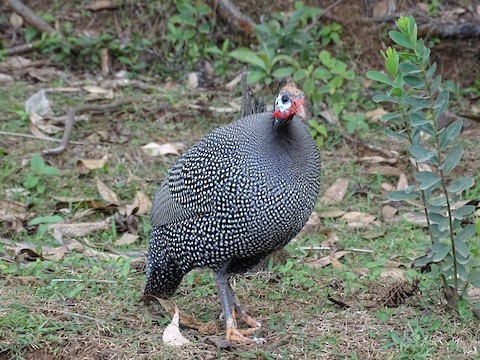
“West African Guineafowl,” N. m. galeatus, showing the red “handlebar moustache” that is characteristic of this form. (Savanne, Mauritius; December 7, 2019.) © Keith Wickens
“West African Guineafowl” (galeatus), the form found across western and central Africa east to the Central African Republic and south to Angola, has a small brown casque, whitish facial skin, and broad, elongated, red cheek-wattles that connect over the cere, forming a “handlebar moustache.”
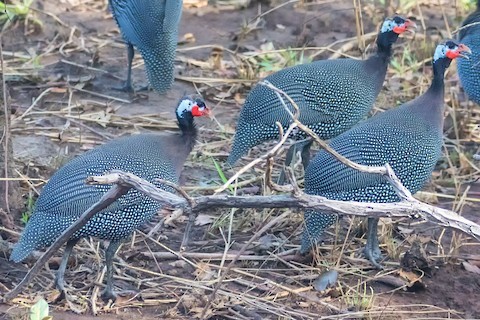
“West African Guineafowl,” N. m. galeatus. (Mole National Park, Ghana; April 1, 2019.) © graichen & recer
“Moroccan Guineafowl” (sabyi), possibly extinct, resembled “West African”, but reportedly had a taller casque and elongated, upward-pointing feathers on the back of the head. Some feral and domestic guineafowl have such feathering—but it is unclear if this is precisely the same appearance as wild sabyi.

“Moroccan Guineafowl,” N. m. sabyi—attributed to sabyi, but location not specified—note that feathers on hindcrown extend above the peak of the casque. (May 18, 2008.) © Wiepko Lubbers

“West African Guineafowl,” N. m. galeatus, providing a profile view of its distinctive broad red wattles and short casque. (Caprivi Mutoyo Lodge, Caprivi, Namibia; October 26, 2019.) © Bert Fisher
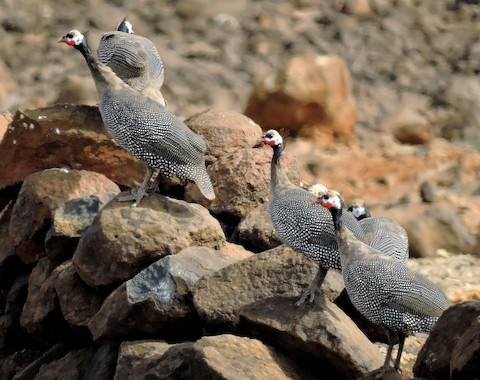
“West African Guineafowl,” N. m. galeatus, showing the white-and-red face pattern that is characteristic of this form. (São Vicente, Boa Vista, Cape Verde; November 7, 2014.) © Georges Olioso
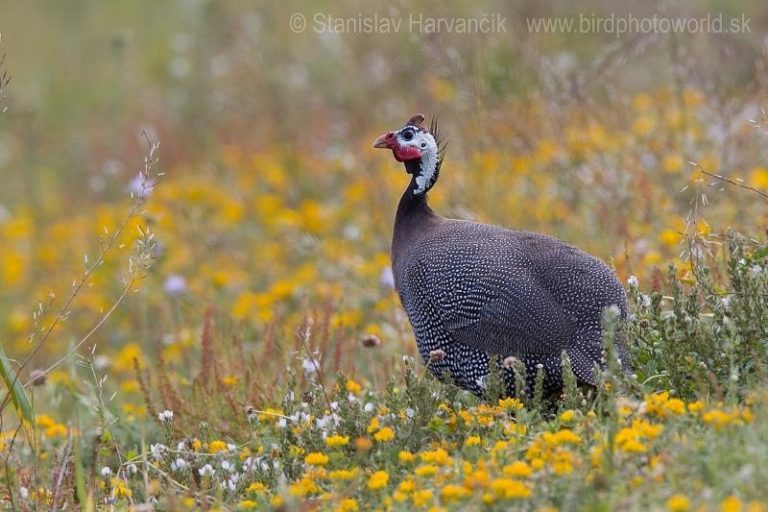
“Moroccan Guineafowl,” N. m. sabyi—attributed to sabyi, possibly feral or domestic in the photographer’s judgment. (Sidi Bou Ghaba, Kenitra, Morocco; April 8, 2015.) © Stanislav Harvančík
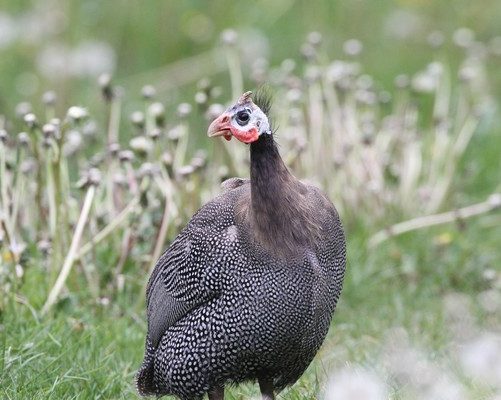
“Moroccan Guineafowl,” N. m. sabyi, presumably a feral bird, attributed to sabyi, but location not specified—note the red “handlebar moustache” and tall upward-pointing feathers on the back of the head. (May 15, 2011.) © voyageschezlesoiseaux
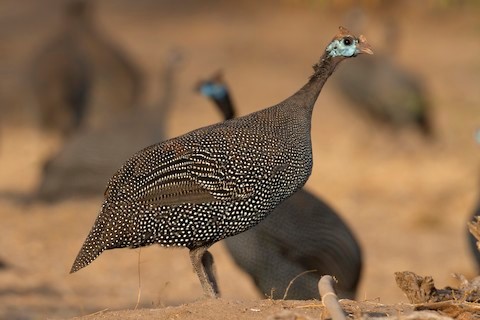
“Ethiopian Guineafowl,” N. m. meleagris. (Bilen Lodge, Afar, Ethiopia; December 29, 2012.) © Marco Valentini
“Ethiopian Guineafowl” (meleagris and somaliensis), the form found across most of eastern Africa south to Rwanda and Kenya, has a short brown casque, pale-blue facial skin, and dense bristles on the cere. Unlike the others, “Ethiopian” has no red skin on its head.
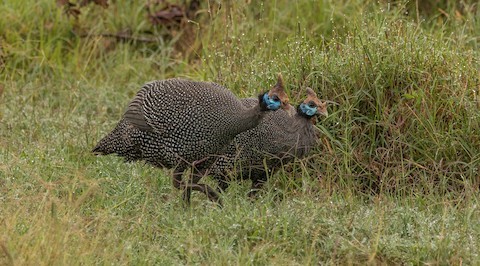
“Ethiopian Guineafowl,” N. m. meleagris. (Ol Pejeta Conservancy, Kenya; November 24, 2019.) © Joel Strong
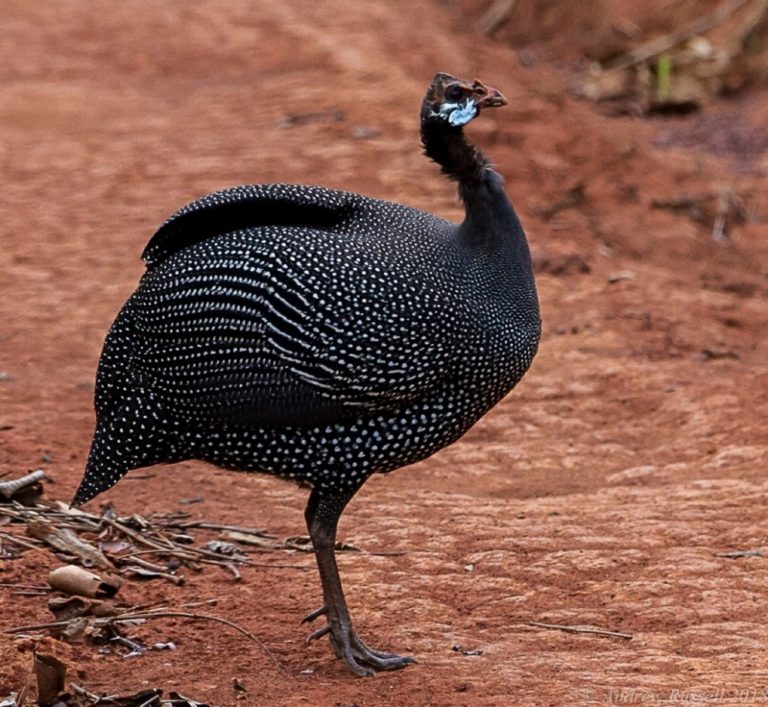
“Ethiopian Guineafowl,” N. m. meleagris. (Mbomou, Central African Republic; June 16, 2018.) © andrewjr
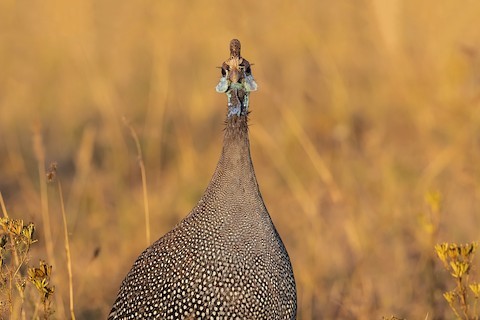
“Ethiopian Guineafowl,” N. m. meleagris, showing the rounded profile of its casque, and flared all-bluish cheek-wattles. (Yabello, Oromia, Ethiopia; December 30, 2019.) © Stefan Hirsch
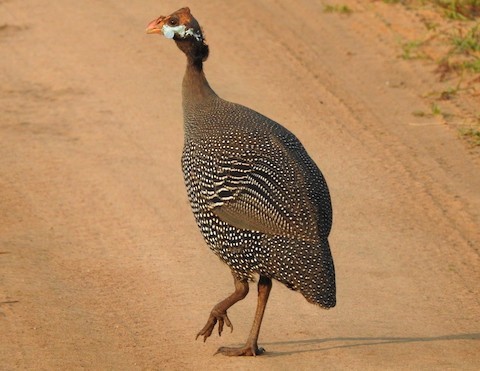
“Ethiopian Guineafowl,” N. m. meleagris. (Murchison Falls National Park, Uganda; June 16, 2019.) © Andy Frank
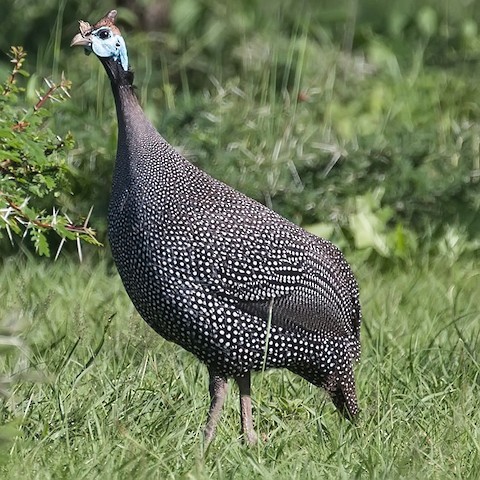
“Ethiopian Guineafowl,” N. m. meleagris—note the cluster of bristles on the cere. (Yabello, Oromia, Ethiopia; October 30, 2019.) © www.aladdin.st
“Reichenow’s Guineafowl” (reichenowi), localized on the savannas of Kenya and Tanzania, has a remarkably tall, orange-brown casque, bright aqua-blue facial skin, black throat-wattles, broad, red cheek-wattles that connect over the cere, forming a “handlebar moustache.”
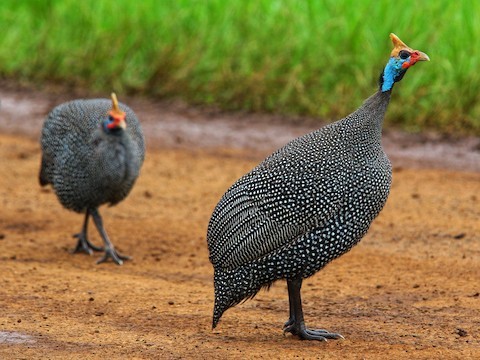
“Reichenow’s Guineafowl,” N. m. reichenowi, showing characteristically bright, tricolor head pattern of orange-brown casque, turquoise cheek and neck, and red “handlebar moustache.” (Nairobi National Park, Kenya; June 5, 2019.) © Arco Huang
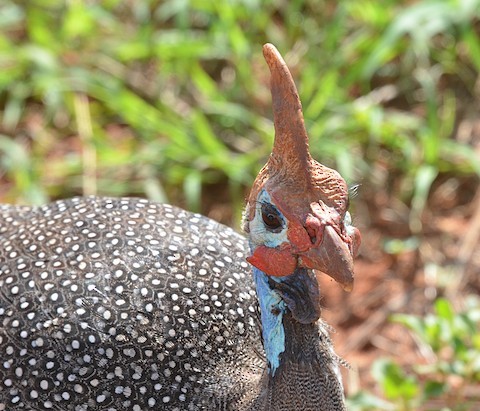
“Reichenow’s Guineafowl,” N. m. reichenowi, close-up showing the structure of its tall vertical casque. (Taita Hills Wildlife Sanctuary, Kenya; March 7, 2017.) © Roland Gerstmeier
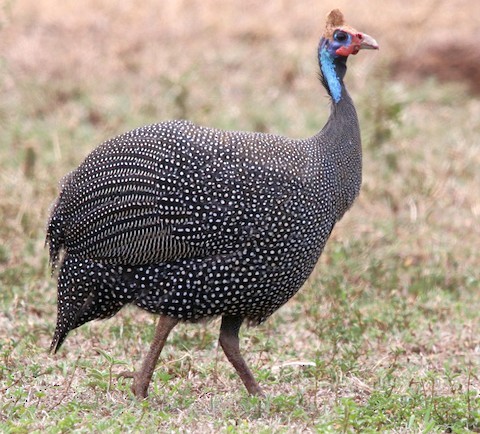
“Reichenow’s Guineafowl,” N. m. reichenowi, with a small casque. (Amboseli National Park, Kenya; October 6, 2019.) © Loren Kliewer
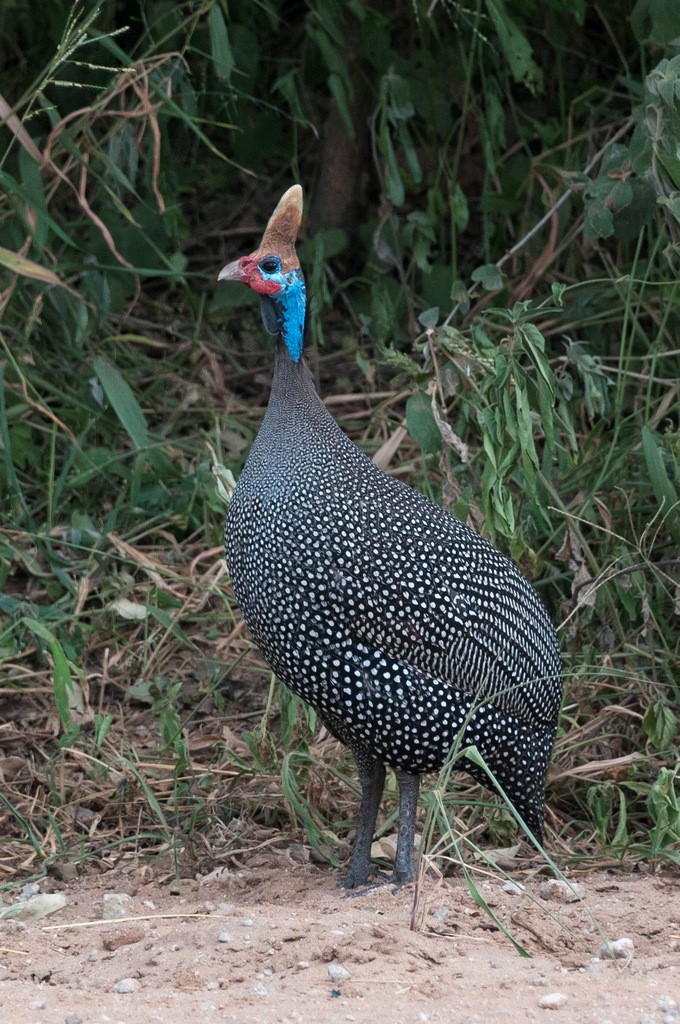
“Reichenow’s Guineafowl,” N. m. reichenowi, showing its distinctively tall, vertical casque. (Tarangire National Park, Tanzania; February 14, 2015.) © Joni Overbosch
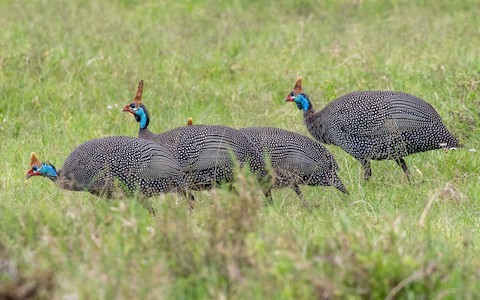
“Reichenow’s Guineafowl,” N. m. reichenowi, showing the blue skin color prominent at a distance—note the variation in casque height. (Lake Naivasha, Kenya; December 3, 2019.) Anonymous eBirder
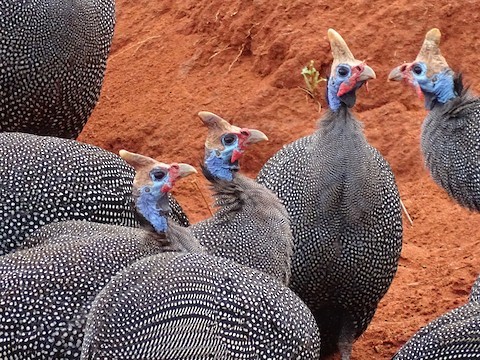
“Reichenow’s Guineafowl,” N. m. reichenowi, a group showing somewhat unusual coloration, including limited red cheek-wattles and purplish skin on their necks. (Tsavo East National Park, Kenya; August 2, 2017.) © Doris Schaule
“Tufted Guineafowl” (mitratus, marungensis, papillosus, and coronatus), the widespread southern form found north to Angola the D.R. Congo, and Tanzania, has a medium-sized or tall brown casque with a red, carunculated base, bright aqua-blue face and neck with deep-blue-to-purplish throat-wattles; and thin, pointed, blue cheek-wattles with red tips.
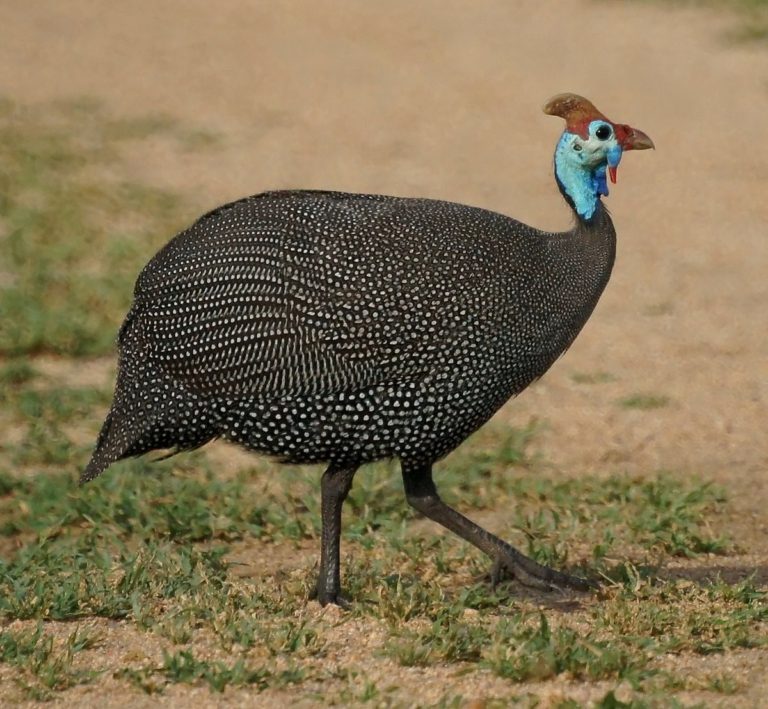
“Tufted Guineafowl,” N. m. mitratus. (Kruger National Park, South Africa; December 12, 2011.) © Mike Pazzani
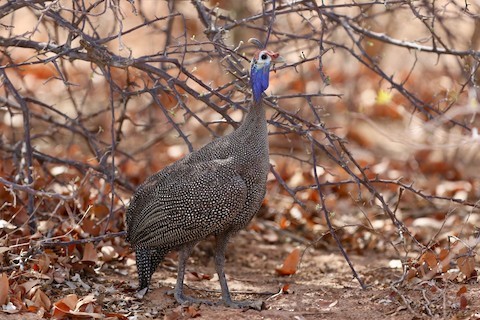
“Tufted Guineafowl,” N. m. papillosus, prominently showing its violet dewlap—a feature that is unique to this form. (Etosha National Park, Namibia; November 14, 2019.) © Krista Oswald

“Tufted Guineafowl,” N. m. coronatus. (Mlawula Nature Reserve, Lubombo, Eswatini; December 27, 2015.) © Kate Braun
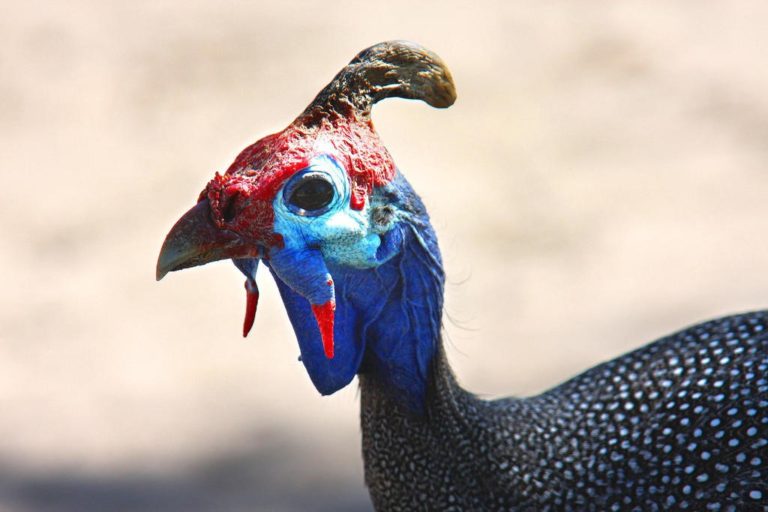
“Tufted Guineafowl,” N. m. papillosus, with extreme coloration and irregularly shaped bare parts. (Sunday Pan, Central Kalahari Game Reserve, Botswana; March 31, 2013.) © Barbara Schneider
Mixed Heritage. Hybrids and intergrades (the latter referring to long-term genetic blending) can be confusing:
In central Kenya, “Reichenow’s” apparently intergrades with “Ethiopian.” Most individuals of apparent mixed ancestry typically have the facial pattern of “Ethiopian” (no red skin) and the tall casque of “Reichenow’s.”
Another variant that may result from hybridization of “Reichenow’s” and “Ethiopian” more closely resembles “Tufted” in that it has blue cheek-wattles with small red tips. However, these birds lack the extensive red carunculations of “Tufted.”
The two forms that are most widely introduced, “West African” and “Tufted,” sometimes hybridize with each other, and produce offspring that resemble “Reichenow’s” in having a tall casque, bluish facial skin, and red cheek-wattles that connect over the cere, form a “handlebar moustache.”
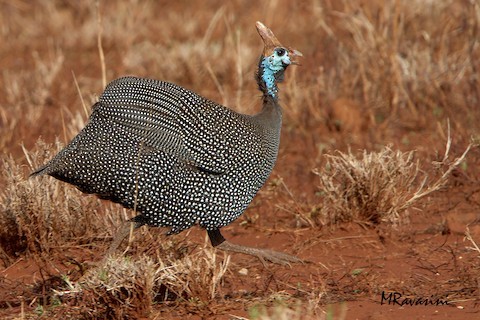
Apparent intergrade or hybrid between “Reichenow’s” and “Ethiopian Guineafowl,” N. m. reichenowi and meleagris, with “Reichenow’s” casque and coloration but lacking red cheek-wattles. (Meru National Park, Kenya; December 5, 2018.) © Maurizio Ravasini
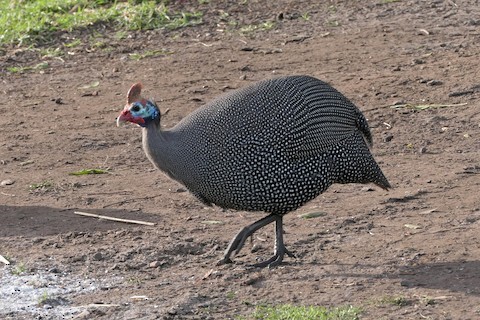
Apparent hybrid between “West African” and “Tufted Guineafowl,” N. m. galeatus and papillosus, with “West African’s” red handlebar moustache and cheek-wattles, and “Tufted’s” casque and facial skin color—this individual’s appearance is largely consistent with “Reichenow’s Guineafowl,” N. m. reichenowi, but the location suggests that it is more likely to be a hybrid of “West African” and ”Tufted.” (Wilderness National Park, Western Cape, South Africa; August 11, 2019.) © Ray Turnbull
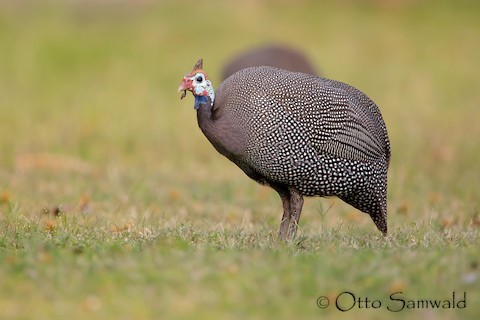
Apparent hybrid between “West African” and “Tufted Guineafowl,” N. m. galeatus and papillosus. (Kaisosi River Lodge, Okavango, Namibia; September 26, 2018.) © Otto Samwald
Voice. The forms seem to vary somewhat in their principal vocalizations. Advertising calls include a rollicking, musical, trumpeted phrase, repeated over and over (“Reichenow’s”): And far-carrying trumpets of nasal honks in brief phrases, repeated persistently (“Tufted”):Many calls are hoarse, nasal squawks, repeated endlessly, and sometimes building or falling in intensity (“West African”):And “Tufted”:And “Reichenow’s”:Often choppy and reverberating (“West African”):And “Ethiopian”:And “Tufted”:Sometimes sharp and squeaky (“Tufted”):Contact calls include crisp chip notes, repeated often (“Ethiopian”):
Notes
Polytypic species consisting of nine recognized subspecies that represent five distinct forms—four of which have apparent potential to be classified as separate species (see Frontiers of Taxonomy: The Many-Helmeted Guineafowl, an Awkward Foursome):
“Moroccan Guineafowl” (sabyi): formerly North Africa from Morocco to Tunisia.
“West African Guineafowl” (galeatus): tropical western Africa in the Sahel and southwest; widely introduced elsewhere.
“Ethiopian Guineafowl” (meleagris and somaliensis): central and eastern Africa in the Sahel and south to Kenya.
“Reichenow’s Guineafowl” (reichenowi): central Kenya to central Tanzania.
“Tufted Guineafowl” (mitratus, marungensis, papillosus, and coronatus): southern Africa from central Angola, Rwanda, and eastern Tanzania south; introduced to Madagascar.
References
BirdLife International. 2018. Numida meleagris. The IUCN Red List of Threatened Species 2018: e.T22679555A132052202. https://dx.doi.org/10.2305/IUCN.UK.2018-2.RLTS.T22679555A132052202.en. (Accessed April 15, 2020.)
eBird. 2020. eBird: An online database of bird distribution and abundance. Cornell Lab of Ornithology, Ithaca, N.Y. http://www.ebird.org. (Accessed April 19, 2020.)
Garcia-del-Rey, E. 2011. Field Guide to the Birds of Macaronesia: Azores, Madeira, Canary Islands, Cape Verde. Lynx Editions, Barcelona.
Hollom, P.A.D., R.F. Porter, S. Christensen, and I. Willis. 1988. Birds of the Middle East and North Africa. T & AD Poyser, Calton, England.
Hume, J.P. 2017. Extinct Birds (Second Edition). Bloomsbury Publishing PLC, London.
Kirwan, G.M., A. Levesque, M. Oberle, and C.J. Sharpe. 2019. Birds of the West Indies. Lynx Edicions, Barcelona.
Madge, S., and P.J.K. McGowan. 2002. Pheasants, Partridges, and Grouse: A Guide to the Pheasants, Partridges, Quails, Grouse, Guineafowl, Buttonquails, and Sandgrouse of the World. Princeton University Press, Princeton, N.J.
Martínez, I., and G.M. Kirwan. 2020. Helmeted Guineafowl (Numida meleagris). In Handbook of the Birds of the World Alive (J. del Hoyo, A. Elliott, J. Sargatal, D.A. Christie, and E. de Juana, eds.). Lynx Edicions, Barcelona. https://www.hbw.com/node/53526. (Accessed April 15, 2020.)
Mullarney, K., L. Svensson, D. Zetterström, and P.J. Grant. 1999. Birds of Europe. Princeton University Press, Princeton, N.J.
Raffaele, H., J. Wiley, O. Garrido, A. Keith, and J. Raffaele. 1998. A Guide to the Birds of the West Indies. Princeton University Press, Princeton, N.J.
Sinclair, I., P. Hockey, W. Tarboton, and P. Ryan. 2011. Birds of Southern Africa (Fourth Edition). Random House Struik (Pty) Ltd. Cape Town, South Africa.
van Perlo, B. 2002. Birds of Western and Central Africa. Princeton University Press, Princeton, N.J.
Xeno-Canto. 2020. Helmeted Guineafowl – Numida meleagris. https://www.xeno-canto.org/species/Numida-meleagris. (Accessed April 18, 2020.)
